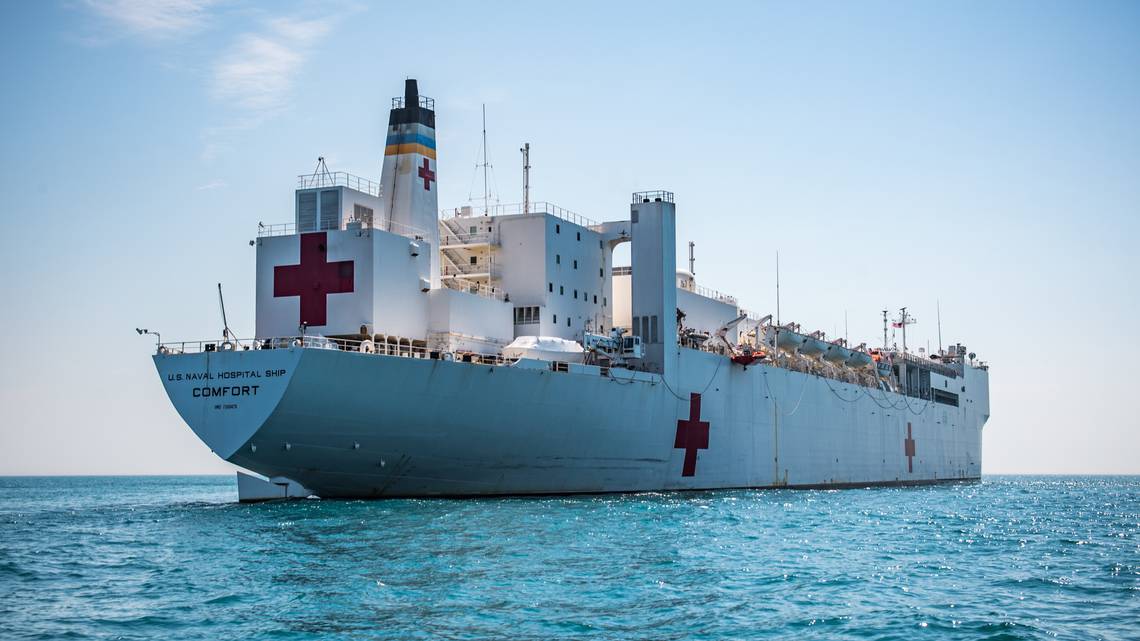U.S. Navy hospital ship to comfort Venezuelan migrants
Defense Secretary Jim Mattis said Friday he would dispatch a U.S. Navy hospital ship to the Colombian coast to help treat Venezuelan refugees that have overwhelmed the Colombian medical system — the first U.S. military foray into the Venezuela crisis.
“It is absolutely a humanitarian mission. We’re not sending soldiers, we’re sending doctors,” Mattis told reporters of his plans to send the gleaming white, former freighter with a Red Cross painted on its side to help treat refugees in Colombia and probably other Latin American nations.
He gave no timetable for when the ship, probably the ship known as the Comfort, would set sail from its home port, likely Norfolk, Virginia.
U.S. defense officials have yet to say how the ship would be outfitted for the Venezuelan refugee health care relief mission. In times of war, the Comfort can carry 1,215 military medical personnel, conduct 12 simultaneous surgeries, operate 1,000 hospital beds and ferry casualties by helicopter. Typically, it has carried a smaller crew with lesser capabilities aimed at providing basic humanitarian relief in hard-to-reach areas or places stricken by natural disaster.
More than a million Venezuelans have fled food shortages and poverty in their homeland in the past 18 months, often traveling by foot and bus to neighboring Colombia and in smaller numbers to Brazil in what the United Nations sees as a refugee crisis. Both countries have tried to shore up security along their land borders while taking in migrants.
The decision to deploy U.S. medical troops to the worst migration crisis in South American history is a significant departure from Trump administration policy. Defense officials have left the response to civilian and international humanitarian relief organizations to deny Venezuelan President Nicolás Maduro the possibility of casting it as a U.S. military intervention in the region.
So far the United States has provided at least $55 million in overall assistance, something defense officials have emphasized particularly since President Donald Trump announced last summer that he was not ”ruling out a military option” to solve the Venezuelan crisis.
Mattis said he had hoped to announce the hospital ship mission in its entirety at the close of his week-long visit, during which the Venezuelan migration crisis came up in every stop.
But Friday, Mattis met with Colombia’s new president and defense minister, and was offered specific suggestions “on how we might best craft the cruise through the region.” That means “going back to the drawing board” before announcing the destinations and timetable, he said. It had yet to be decided, for example, whether the hospital ship would treat Venezuelans on the Atlantic side of the Panama Canal or to the south in the Pacific, a move that might allow the U.S. health care workers to also treat spillover Venezuelan refugees into Ecuador.
If the U.S. pursued that plan, it left open the possibility that the Pentagon would send out the hospital ship Mercy, Comfort’s sister ship, whose home port is in San Diego.
Mattis called the mission “an effort to deal with the human cost of (Venezuelan President Nicolas) Maduro and his increasingly isolated regime.”
“Can you imagine more than a million refugees right now in one of our most populous states, say California, and what that would do for that one state. Put that on steroids down here and you can see why this is a time when one of our fellow democracies is in trouble and we have to come in and help each other.”
Mattis personally championed the idea of the military medical mission earlier this month on the eve of his first trip to South America, an aide said, but waited to consult Colombia’s new President Iván Duque on Friday morning to make it official.
Before Bogota, Mattis made stops in Brazil, Argentina and Chile, and the Venezuela crisis came up repeatedly. He dismissed claims from Caracas that the United States had a role in this month’s thwarted drone attack on Maduro during a speech to hundreds of soldiers in the capital.
“The United States did not, and nobody else did. They can look in the mirror for the problem, Mr. Maduro can,” the retired Marine general told reporters. “Everyone knows that they’ve created their own problems there.”
The 894-foot-long Comfort’s landing pads can accommodate both medevac and heavy-lift helicopters, that could set up or supply field hospitals. It can also anchor offshore and bring on patients through side ports. It has regularly visited the Caribbean and Central America on goodwill missions as well as humanitarian relief efforts after natural disasters.
The Venezuelan refugee mission will be the sixth hospital ship deployment to the Western Hemisphere since 2007, a Pentagon statement said. Its last known humanitarian relief mission to the region was in October when it anchored off Puerto Rico to help those harmed by Hurricane Maria.

